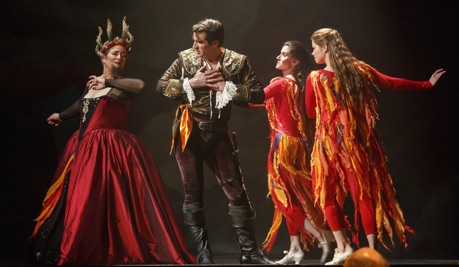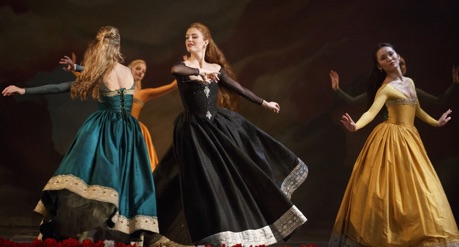Reviews 2016






✭✭✭✭✩
by Henry Purcell, directed by Marshall Pynkoski
Opera Atelier, Elgin Theatre, Toronto
October 20, 22, 23, 25, 28 & 29, 2016
“Purcell’s masterpiece revitalized”
Opera Atelier’s new production of Dido and Aeneas is a great success. The company’s former production of the work had been its calling card on tours throughout Europe and Asia 1995. The company now presents the piece on its own rather than as part of a double bill and with a sleeker yet still historically informed design. Mezzo soprano Wallis Giunta, leading an all-Canadian cast, gives a ravishing performance as Dido and director Marshall Pynkoski’s rethinking of the work reinvigorates every aspect of the production from the music to the acting and design.
Pynkoski’s greatest change is to add a twenty-five-minute-long prologue combining music, dance, and spoken word. As Pynkoski explained in his usual pre-performance speech, he wished to give the audience the same background as the opera’s original audience would have had. After the sounds of drums, a wood block and a rattle reminiscent of Japanese Noh theatre, actor Irene Poole declaimed with great feeling excerpts from Robert Fagles’s translation of Virgil’s Aeneid explaining Juno’s enmity toward Aeneas, his being blown off course by Aeolus and Neptune, his shipwreck on the coast of Libya and his arrival in Carthage. While Poole initially spoke unaccompanied, the Tafelmusik Baroque Orchestra under David Fallis eventually joined in playing various excerpts of Purcell’s music for theatre from other sources. Following Poole’s narration, the Atelier Ballet, choreographed by Jeannette Lajeunnesse-Zingg, depicted the shipwreck and arrival in Carthage leading to a pantomime by Wallis Giunta as Dido and Christopher Enns as Aeneas of the couple’s first meeting and falling in love.
Of course, Purcell’s opera does not really need an explanatory prologue, but the quotations from the Aeneid, the selections from Purcell’s music and the initial ballet did establish the appropriate atmosphere for the opera and provided an introduction for any newcomers to Opera Atelier’s performance style. The difficulty in quoting the source of Nahum Tate’s libretto is that Tate contradicts his source by blaming the title couple’s travails not on Juno but on a local Sorceress. The greatest difficulty though is having the majority of Poole’s narration accompanied by Purcell’s music. Fagles' translation and Purcell’s music are each so powerful one would rather hear each separately. A simple solution would be to have Poole finish her narration before beginning Purcell’s music and the ballet.

The costume design continued OA’s tradition of dressing the performers in the period of the work rather than in the period of the story. The extravagant women’s costumes by Dora Rust-D’Eye for the earlier production ware replaced by the simpler gowns of Michael Legouffe whose elegant lines still suggested gowns of the 17th century. The men’s costumes as Trojans consist of musketeer boots, leggings and gilets over blousy shirts. Those familiar with the previous production will be pleased that Legouffe has retained the whimsical frigate headdress for the Sailor’s dance. For the The Sorceress’s attendant witches, however, Legouffe set aside period design in favour of modern unitards covered in streamers representing flames.
The most important musical change was to replace the chorus of adults with the 22-member Toronto Children’s Chorus Choral Scholars aided by eight men from the Opera Atelier Chorus. The point was to make a nod toward the opera’s original production by Josias Priest’s girls’ school in 1689. The sound produced was very like that of a fine English cathedral choir. The presence of children’s voices created an atmosphere of innocence appropriate to the work as well as lending more resonance to the libretto’s frequent mention of Cupid. One of the most delightful passages is the echo chorus in Act 2. Watch the choristers in the boxes to the right of the stage cover their mouths with their cupped hands to create the echo effect.
Accoring to Lajeunnessse-Zingg’s “Choreographer’s Notes”, Purcell’s score has indications for seventeen dances though he wrote down music for only three of them. Therefore, Lajeunnessse-Zingg and Fallis added two chaconnes to the the body of the opera and a final minuet after Dido’s death as Purcell indicated. Those accustomed to previous performances of the opera will be surprised that it continues beyond Dido’s death. Yet the final minuet of mourning feels right since it allows the import of Dido’s death to sink in before the applause begins. This, along with encores of popular numbers means that the evening is equally balanced between song and dance.

Making her role debut as Dido, Wallis Giunta displays a voice of extraordinary power and beauty. She has a mezzo soprano blessed with both clarity and depth and her exceptional control allowed her to colour key words and phrases to achieve the greatest dramatic effect. She has completely mastered Opera Atelier’s stylized acting technique and makes it seem a natural expression of emotion. Encouraged by Pynkoski’s reading of the Aeneid, Giunta’s account of “Ah! Belinda” is does not portray Dido as somehow gloomily intimating Aeneas departure, as is commonly the case. Rather Giunta’s interpretation emphasizes that Dido is oppressed by the weight of overwhelming love. Giunta’s moving account of “When I am laid in earth” was exquisite in its attention to detail and shading of tone.
For his part, Christopher Enns has also mastered Opera Atelier’s acting style and sings Aeneas in a light, agile tenor. His finest moment is his account of Aeneas’ “But ah! what language can I try” where he fully conveyed Aeneas’ distress at having to announce his departure to Dido.
Soprano Meghan Lindsay provides elegantly phrased support as Dido’s sister and hand-maid Belinda and mezzo-soprano Laura Pudwell sings the role of the bearded Sorceress in a voluptuous tone spiced with a wry sense of humour. Ellen McAteer and Karine White are effective as the First and Second Witches.
David Fallis conducted the 18-member Tafelmusik Baroque Orchestra in a stirring and vivid account of the score that makes it sound completely fresh. The band’s unanimity of playing, precision of attack and a wonderfully resonant sound are a constant pleasure. In this new production Pynkoski and Lajeunnesse-Zingg achieve their ideal of fully integrating dance with opera, helped in no small measure by the dancer-like figures and physical agility of both Giunta and Enns, who easily blend in as occasional dancers with the corps de ballet. One leaves the opera feeling elated as if one had encountered a deserving old friend revitalized by good fortune.
©Christopher Hoile
Note: This is a version of the review that will appear later this year in Opera News.
Photos: (from top) Wallis Giunta as Dido and Christopher Enns as Aeneas; Laura Pudwell as the Sorceress, Christopher Enns as Aeneas, Ellen McTeer as First Witch and Karine White as Second Witch; Wallis Giunta as Dido with artsist of the Atelier Ballet. ©2016 Bruce Zinger.
For tickets, visit http://operaatelier.com.
2016-10-23



Dido and Aeneas





